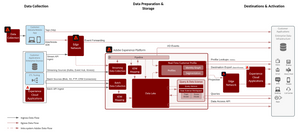
Anatomy of an AEP Project
06 Mar 2022 » Platform
I remember being a bit nervous before my first AEP project. The tool seemed very complex and I had only received the training. Seeing what my coworkers were doing and the questions they had, meant that I saw myself as a noob. However, as I dived into it, it was not as difficult as I initially thought. Of course, it is not an easy tool but, once you get the hang of it, things start to make sense. I also received a lot of support from the experts. In this post, I want to share the approach that you should take in an ideal AEP project.
Before proceeding, let me go back to the previous sentence, in particular, to the word “ideal”. I have put it there very consciously. We live in an imperfect world, while our mental models are perfect. So, what I am going to explain is what this idealized project should look like. You need to remember that you will then have to adapt it to the real world.
The U-Turn
AEP projects are not that different from other types of projects. Let’s consider the following diagram, with the AEP data flow.
We like to draw data flows from left to right. I guess this is because, in Western countries, our languages are written from left to right. So, considering the previous diagram, this is the ideal project progress:
-
Business requirements
- Goals. You should try to start from the far right: what do you want to achieve?
- Segmentation definition. What data do you need to create the segments needed to achieve the desired outcomes?
- Finding the data. Where is the data you need for the segments?
-
Implementation
- Data sources. Build the integration between your data sources and AEP to receive the needed data.
- Segmentation. Setup the segments, according to 1.b.
- Destinations. Send the data to the activation tools.
So, you start from the right, go all the way to the left, and then back to the right. This is why I call it the U-turn. I am sure you have seen similar approaches like this in the past: AEP is not reinventing the wheel.
Business Requirements
We are all guilty of trying to skip the business requirements and going straight to the technical implementation. When you like technology, you like to play with it. However, I always say that, if you want to play with technology, you should buy a Raspberry Pi and build a cool project.
Goals
I have to admit that I have mixed feelings regarding this first step. On the one hand, I agree that having a set of use cases makes our lives easier. It also protects us in various ways. On the other hand, though, not all clients know exactly where they want to go, but at least know the direction they want to take.
I would like to write a post in the future about my points of view. For now, let’s just assume that the first step is to have some clarity of the goals of the project, in writing. It does not have to be a long list of details but, at least, some form or “North Star”. Remember that the worst-case scenario is paralysis by analysis, as you end up with nothing.
Some examples of these goals are:
- I want to send an email to my loyalty members on their birthday with a 10% coupon.
- When someone logs in to my website and they have an upcoming flight, I want to add a button to the check-in page.
- I want to offer a credit card to my customers with a balance over $50,000.
Segmentation definition
You will have noticed that both steps 1.b and 2.b include the word “segmentation”. In 1.b, what you should aim at is defining the audiences you want to address. They should directly come from the first step. If I continue with the examples I have given:
- Segment 1:
- Loyalty members whose birth date (without the year) is today
- Excluding those who have received already the coupon in the last 364 days
- Segment 2:
- Loyalty members who have a flight in the next 7 days
- Exclude those who have already checked in
- Segment 3:
- Bank customers with a total balance of over $50,000
- Excluding those who already have a credit card
- Excluding those who have a low credit score
Finding the data
In my experience, this step tends to be the most difficult. This is when you have to work with your customer or internal teams to find where the data is stored. Be prepared to find various types of issues:
- As surprising as it may sound, some companies do not always know where they have all their data stored or who owns it. Getting to the bottom of it can be a lengthy process.
- Expect legal issues, especially when sending the data to the cloud.
- Some teams may not want to share their data; they fear that they will lose control or it could expose some flaws in it or they will be made redundant if they share the data.
- Sometimes the data is nowhere to be found! The marketer expects some data points that have never been collected, making the use case impossible or, at least, delaying it until the data is gathered.
- The data may belong to a 3rd party and may want to charge for it.
Continuing with my example, these could be the data sources that you would be looking for:
- Segment 1:
- Loyalty data, which could be spread in various databases
- Email logs or coupon redemption logs
- Segment 2:
- Loyalty data
- Reservation information (from the PSS)
- Segment 3:
- Customer data
- Balances from customers
- List of customers with a credit card
- Credit scores
Implementation
By now, you have reached the far left of the diagram and you have to make the U-turn I mentioned earlier. Also, it is time to switch from a business focus to a technical mindset.
Data Sources
This is when you put your plumber hat on, as you will be connecting the pipes from the data sources to AEP. I said that step 1.c (finding the data) was the most difficult. Well, some may contend that and say that 2.a is actually more complex. You will see that in a few seconds. For each data source, you may find various cases:
- All Adobe tools that can send data have integrations with AEP (no surprises here).
- If you are lucky, AEP already has an out-of-the-box integration with that data source. Check the page on source connector overview, as new connectors are being added regularly.
- If you are not that lucky, you will have to work more:
- Use one of the generic connectors: Amazon S3 buckets, Azure blob storage, SFTP…
- Or the generic HTTP API to send the data in streaming.
- Expect to use an ETL tool or build a microservice to bridge the gap between the data source and AEP.
- If the data format is not in XDM format, you will likely need to use the data prep functionality.
- Some use cases require the use of query services. In fact, I am seeing this functionality being key in more and more customers.
Segmentation
This is probably the simplest step of all. You have the data sources and the segmentation definition. All you need to do is to follow the guide and create the segments using the data you should already have.
Destinations
AEP, like AAM, does not directly engage with your customers. You need to send the segmentation data to other systems. The situation is similar to that of data sources:
- Adobe tools and services are easily configured through the UI.
- AEP also has many out-of-the-box destinations; check them out first.
- If you cannot find your destination, you will have to do some extra work:
- Use one of the generic destinations, which are very similar to those in the data sources side: Amazon S3, Azure blobs, SFTP.
- Again, expect the need for an ETL or microservice.
- You may also need to check the destination API to build your destination connector.
Hooray! You made it! Now you can target your audiences as intended.
No Requirements
More often than expected, the project is led by IT, without the blessing of the marketing team. I am not sure this is always bad, especially if the marketing team need a push to evolve to more modern marketing tactics. However, the consequence is that there may not be business requirements. Or the business team does not have a clear picture of what they want.
What to do in this case? Well, the only option you have is a project that goes from left to right. You have the risk of not having the required data once the marketing team starts using the implementation and you should highlight it. On the other hand, if you are a seasoned consultant, I suggest you rely on your gut feeling. Your experience will guide the project quite well.
Finally, focus on capabilities. While you do not know how the marketers will use the AEP project, you know that some capabilities will very likely be needed. Look for any list of digital marketing capabilities and enable as many as possible. There will still be gaps in the end, but I believe this is better than waiting until the marketing team has decided what they want.
Photo by Daria Nepriakhina on Unsplash
